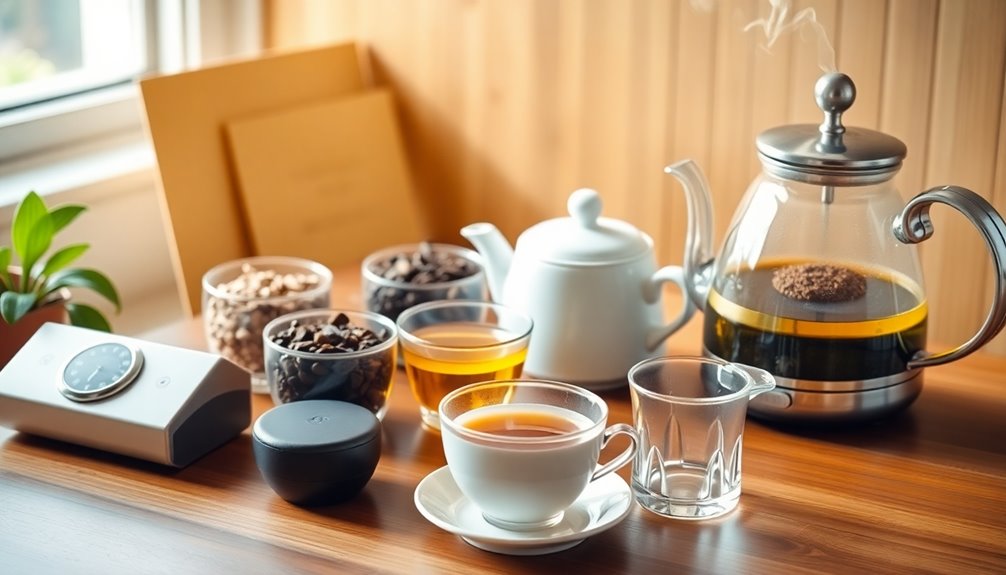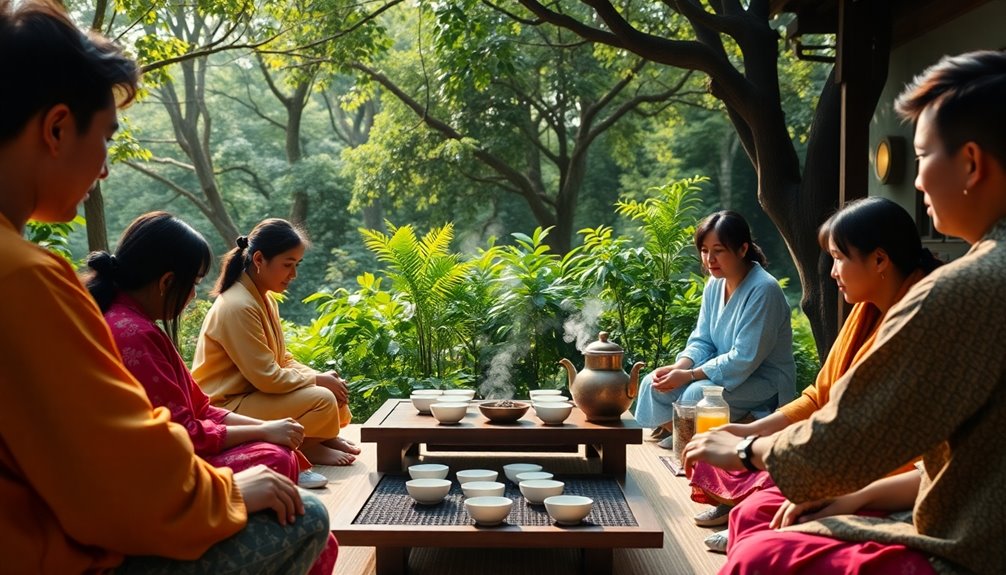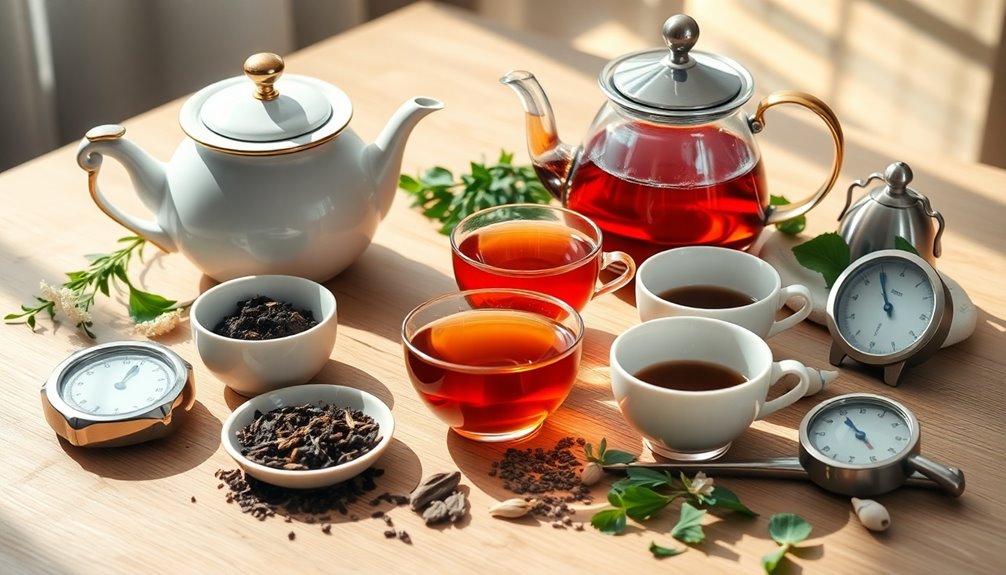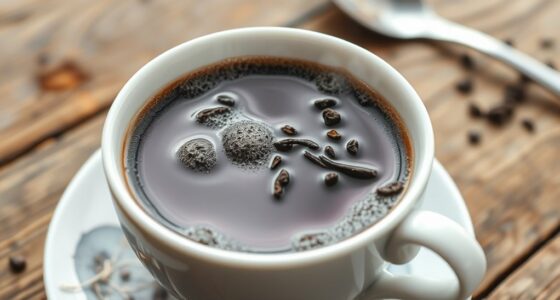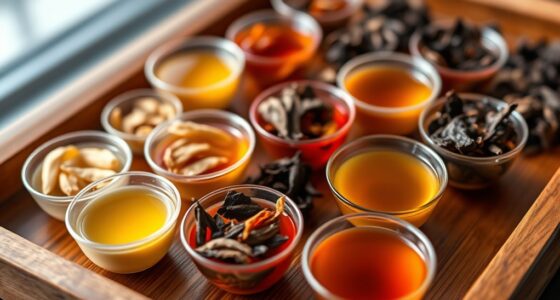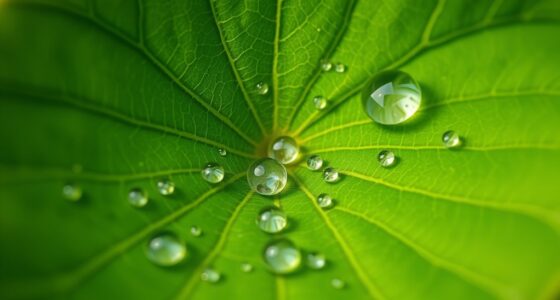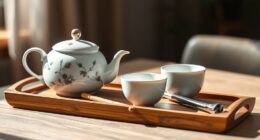Brewing tea can be a fun adventure! To get started, remember that different teas need different temperatures and steeping times. For example, black tea prefers hot water around 200°F, and it should steep for 3-5 minutes. Green tea enjoys a cooler bath at about 160°F for just 2-3 minutes. Don't forget that loose leaf tea is often tastier than tea bags! Also, use one teaspoon of tea for every cup of water, and feel free to experiment with brewing methods like a French press or an Aeropress. Stick around, and you'll discover even more tips for your tea journey!
Key Takeaways
- Use the recommended water temperature: black teas at 200-212°F, green teas at 160-180°F, and white teas at 160-175°F for optimal flavor.
- Steep black teas for 3-5 minutes, green teas for 2-3 minutes, and white teas for 4-5 minutes to avoid bitterness.
- For herbal tisanes, use boiling water and steep for 5-15 minutes to extract full flavor.
- Utilize one teaspoon of loose-leaf tea per 8 ounces of water for balanced taste.
- Experiment with various brewing methods like Chemex or Aeropress to enhance flavor and control strength.
Introduction
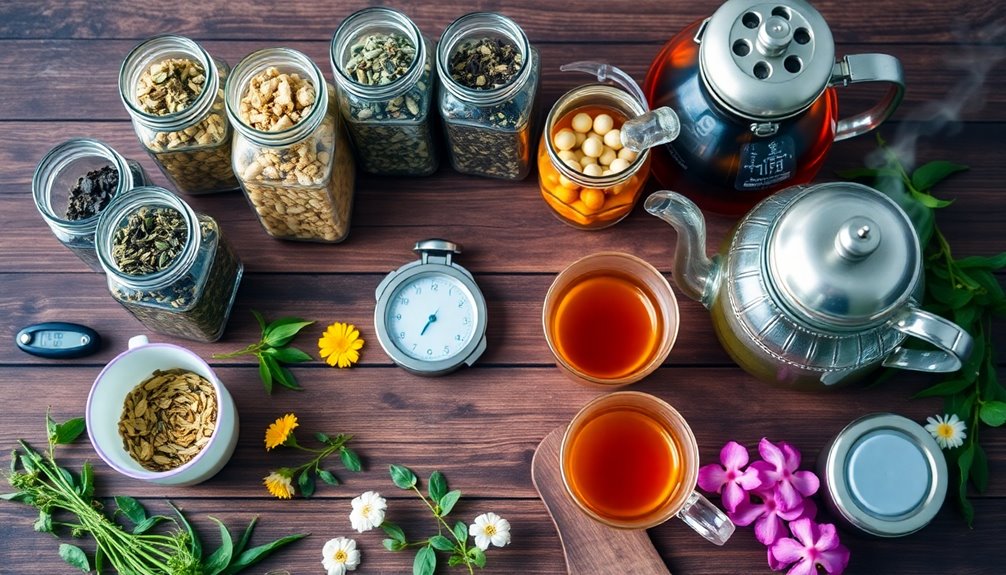
Brewing the perfect cup of tea can seem daunting, but mastering the basics is easier than you might think.
First, let's talk about tea leaves. Using loose leaf tea is like unlocking a treasure chest of flavors! It gives your tea a richer taste compared to those little tea bags. Additionally, many loose leaf teas are packed with antioxidants that can offer various health benefits. In fact, certain types of loose leaf tea, such as green tea, are especially rich in EGCG, promoting metabolic health. Drinking tea can also provide health benefits similar to those found in coffee, including support for gut microbiota health.
Next up, you've got to pay attention to steeping times. Different teas, like black, green, or oolong, have unique steeping times and water temperatures that make all the difference.
Now, let's not forget about water! Ideally, you should use filtered or spring water. This can really boost the taste and clarity of your tea. If you've ever tasted a cup made with tap water, you'll know what I mean!
Experimenting is key. Try different tea-to-water ratios and steeping techniques to find what you love best. You might discover that you like your green tea a little stronger or your black tea a bit milder. Additionally, incorporating herbal teas into your routine can provide a variety of unique flavors and health benefits.
With a little practice and some fun experimentation, you'll be brewing delicious cups of tea in no time. So grab your tea leaves, and let's get started on this flavorful journey!
Variety of Brewing Methods
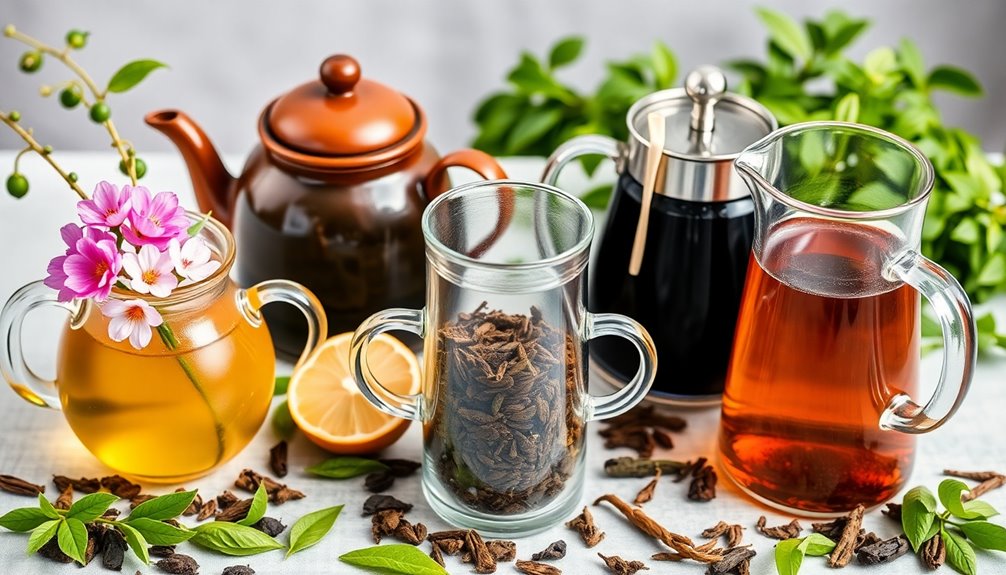
Many tea enthusiasts regularly explore various brewing methods to enhance their tea experience. Each method offers something unique, so let's dive in!
If you love watching your loose leaf tea unfold, the glass infusion method is a delight. You'll see the leaves dance and swirl while steeping, making each cup visually appealing. For teas that need multiple infusions, like puerhs and oolongs, a small glass infuser is perfect. It saves your tea leaves for additional brews, so you get the most flavor out of them!
On the other hand, the Chemex brewing method shines when you're enjoying single-origin teas. It brings out their rich character and clarity.
If you're on a camping trip or just at the office, the Aeropress is your best friend. This nifty gadget gives you a smooth cup of tea while filtering out any pesky particles.
Finally, don't forget about the trusty French press! It lets you control how strong your tea is by adjusting the water-to-tea ratio, giving you a satisfying pour every time.
Brewing Temperature Affects Flavor

Temperature plays a crucial role in unlocking the full potential of your tea's flavor profile. When you're brewing different types of tea, using the right brewing temperature is key.
For example, if you want to enjoy a robust cup of black teas, you should heat your water to a steamy 200-212°F (93-100°C). This high temperature extracts all the bold flavors, giving you a deliciously rich experience.
On the other hand, if you're brewing delicate white teas, keep the temperature lower, around 160-175°F (70-80°C). This helps preserve their subtle flavors and keeps them from becoming bitter.
Green teas like a warm bath too, preferring 160-180°F (70-82°C) for a fresh taste.
Don't forget about herbal tisanes! They love boiling water at 212°F (100°C) to unleash their yummy flavors and nutrients.
Oolong teas, which are somewhere in between, thrive at 185-205°F (85-96°C) for a delightful mix of floral and creamy notes.
Tea Brewing With a Samovar
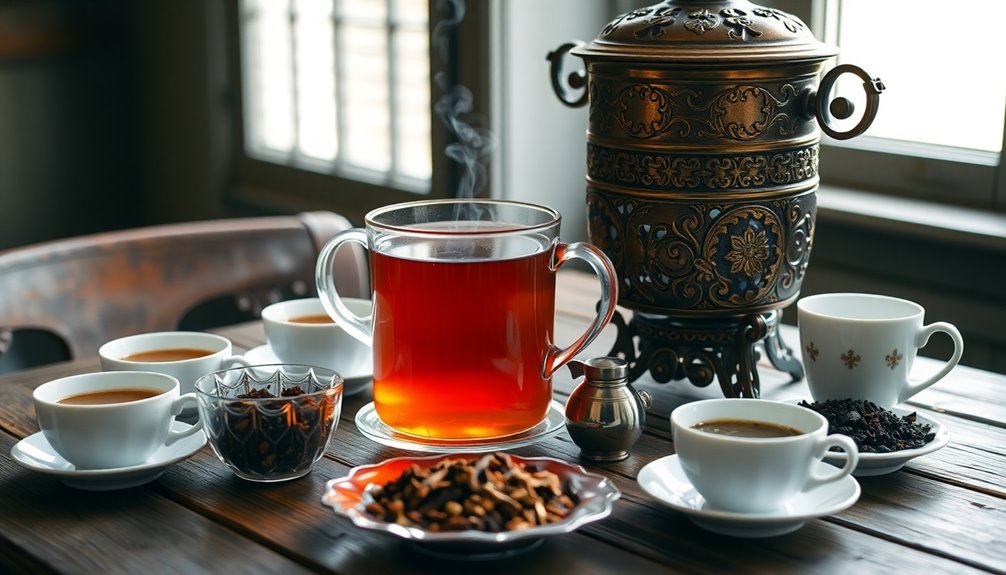
Using a samovar can transform your tea experience, especially when it comes to brewing black teas. This special tea maker lets you create a concentrated tea base that you can dilute to match your taste. It's like having your own tea restaurant at home!
To start, fill the top chamber of the samovar with water and your favorite black tea leaves. While the tea brews, the bottom chamber keeps everything warm, so your tea stays fresh for hours—perfect for those cozy gatherings with friends and family.
Remember, when you're tea brewing with a samovar, it's crucial to steep for the recommended time. Why? Because if you forget and steep for too long, your tea might end up bitter, and nobody wants that!
The great thing about a samovar is that it allows for multiple infusions, letting you enjoy the changing flavors over time, much like a delightful tea adventure.
Brewing Time Discrepancies
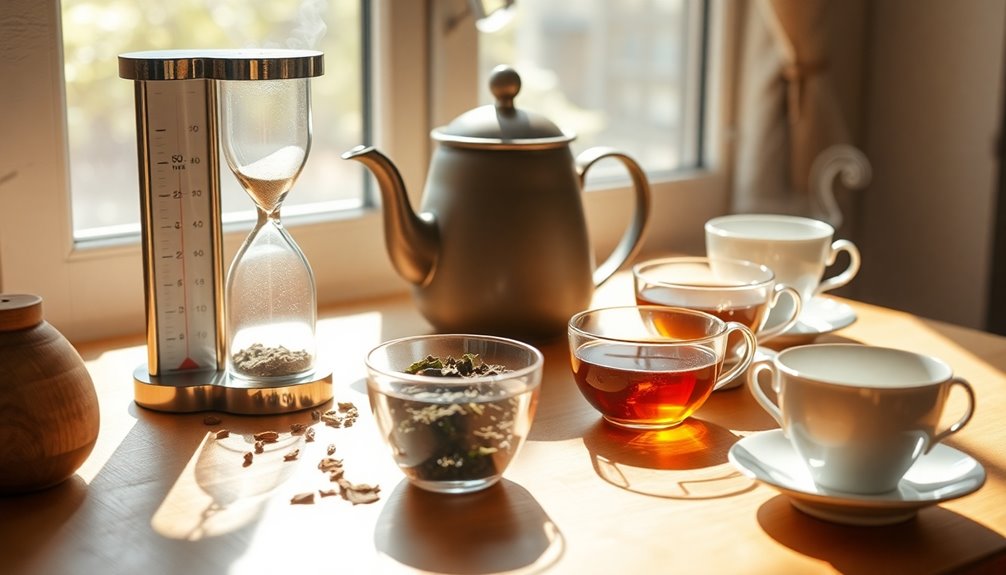
When brewing tea, timing is everything, and each type has its own unique requirements. If you're using a tea bag, remember that brewing times can vary quite a bit!
For example, black teas love to steep for about 3 to 5 minutes, while green teas prefer a quicker dip in the hot water, around 2 to 3 minutes. If you leave green tea too long, it might turn bitter, and nobody wants that!
Herbal tisanes are a bit different; they usually need a longer soak, anywhere from 5 to 15 minutes, depending on the herbs. Oolong teas are like the middle child—3 to 7 minutes is just right for them, helping those complex flavors shine.
And don't forget delicate white teas! They should steep for 4 to 5 minutes in lower-temperature water, around 160°F to 185°F, to keep their subtle taste intact.
Always check specific recommendations for each tea type. The right brewing times can really change how much you enjoy your cup, so let's brew it right and have fun exploring these delicious flavors!
Practical Applications

To brew the perfect cup of tea, you'll want to pay attention to a few key factors. First, pick the right temperature and steeping time for your tea. For example, if you're brewing black tea, heat your water to 200°F and let it steep for 3-5 minutes. For green tea, aim for 175°F and steep for 2-3 minutes. This is important because it helps bring out the flavors!
Next, measure how much tea you use. A good rule is one teaspoon of loose-leaf tea for every 8 ounces of water. Using clean, filtered water makes a big difference too; it keeps your tea tasting fresh and yummy! Additionally, remember that brewing time affects caffeine extraction, so adjust your steeping duration based on your caffeine preferences.
Don't be afraid to experiment with brewing methods! You could try a French press or a small glass infuser to see which one makes your favorite cup of tea.
If you're using loose-leaf tea that can be steeped again, remember to adjust the steeping time for each infusion. You might need to let it steep a bit longer each time to enjoy those different flavor profiles.
Frequently Asked Questions
How to Prepare Different Teas?
To prepare different teas, you'll need to adjust steeping times and temperatures. Use one teaspoon of loose-leaf tea per cup, and always opt for filtered water to enhance flavor. Experiment with multiple infusions for variety.
Can You Brew Different Teas Together?
Yes, you can brew different teas together. Just be mindful of their steeping times and temperatures. Start with small amounts to identify a balance, ensuring their flavors complement rather than clash for a delightful experience.
How to Perfectly Brew Tea?
To perfectly brew tea, use the right water temperature and steeping time for your chosen type. Measure the tea accurately, and always opt for filtered water to enhance the flavor and aroma of your brew.
What Is the Correct Order to Make Tea?
To make tea correctly, start by choosing your loose-leaf tea. Measure the leaves, heat water to the right temperature, steep for the recommended time, then strain and enjoy, customizing with milk or sweeteners if you like.
Conclusion
Now that you know how to brew different teas the right way, you'll never have to guess again! Remember the importance of water temperature and brewing time—these little details can make a big difference in flavor. Whether you're using a samovar or just a simple kettle, experimenting with your favorite teas can be a fun adventure. So, grab your teacups, invite some friends, and enjoy the delightful world of tea together! Happy brewing!

